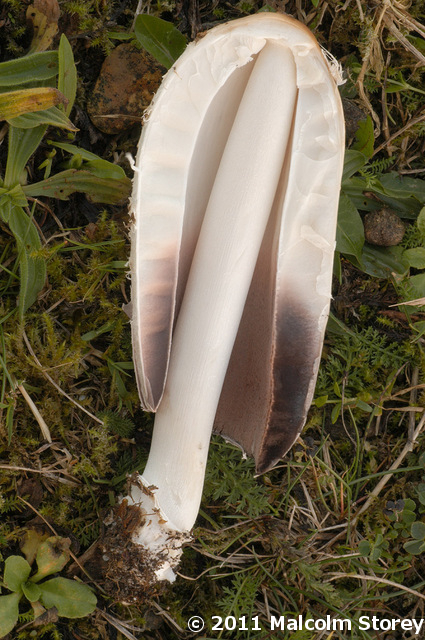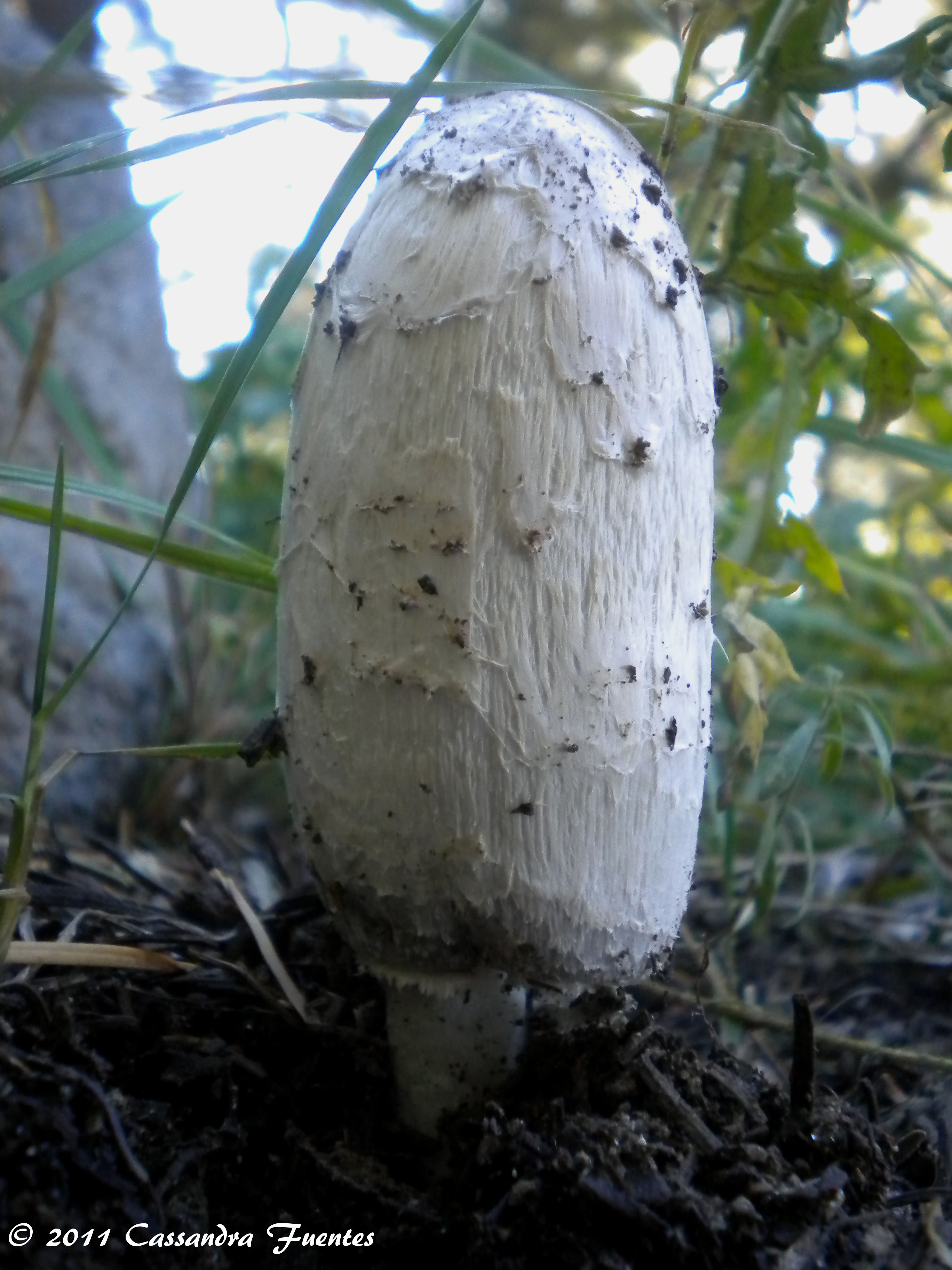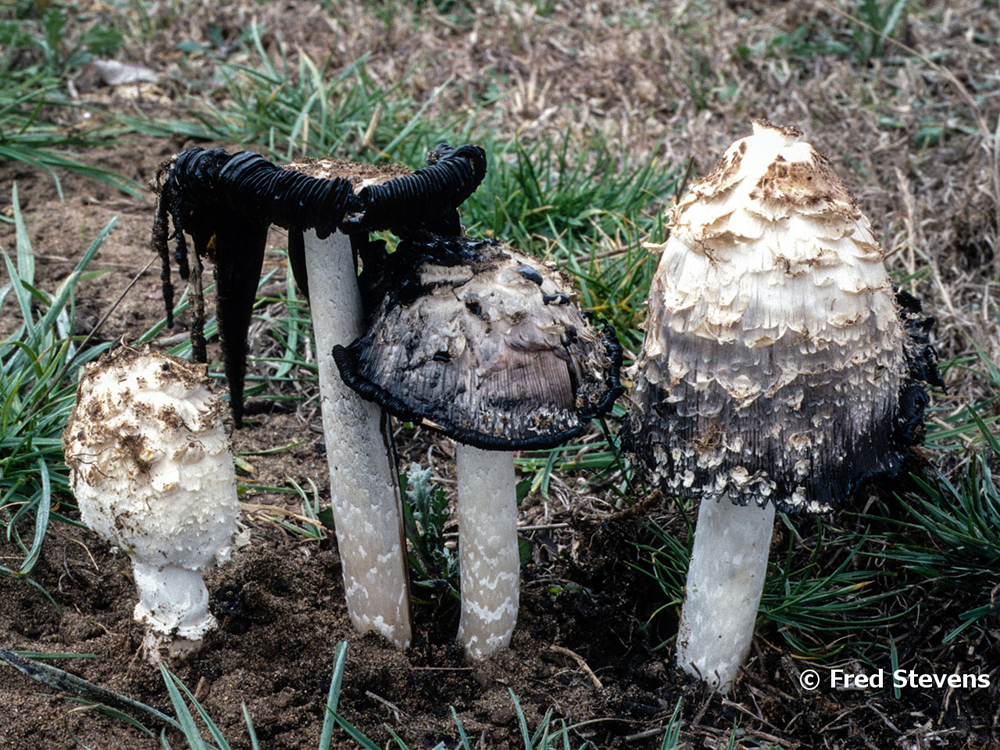Coprinus comatus -- What Is Going On With That Inky Cap? (by )
Mushroom of the Month: February, 2014
Their mass rotted off them flake by flake
Til the thick stalk stuck like a murderer’s stake,
Where rags of loose flesh yet tremble on high
Infecting the winds that wander by.
from The Sensitive Plant, Percy Bysshe Shelley - circa 1820
 Imagine this – you’re a young and growing mushroom fruit-body. In a short amount of time, you’ve been triggered to grow and burst forth from the ground with enough force to break through solid concrete. Once in the atmosphere you’ve been designed to seek, additional triggers create a wave of spores to be released from the bottom of your column-shaped cap. Now, in a seemingly bizarre move, you begin to breakdown the very fibers of your being, turning your once firm cap into a melting mass of black goo. Eventually, nothing is left of your white and scaly brown button but ghostly tatters of dripping, oozing black that flail from a defiantly upright and bony looking stipe…
Imagine this – you’re a young and growing mushroom fruit-body. In a short amount of time, you’ve been triggered to grow and burst forth from the ground with enough force to break through solid concrete. Once in the atmosphere you’ve been designed to seek, additional triggers create a wave of spores to be released from the bottom of your column-shaped cap. Now, in a seemingly bizarre move, you begin to breakdown the very fibers of your being, turning your once firm cap into a melting mass of black goo. Eventually, nothing is left of your white and scaly brown button but ghostly tatters of dripping, oozing black that flail from a defiantly upright and bony looking stipe…
Such is the scenario for the Coprinus comatus mushroom. It is a fascinating and at times powerful scenario known in biological terms as deliquescence or auto-deliquescence, and is one of the key morphological characteristics associated with this long-appreciated edible mushroom. Auto-digestion has also been used as a defining feature within mycological taxonomy and in part made this fungus the center of recent debate and shifts in categorization.
So what’s happening when Coprinus comatus turns itself into a puddle on a stick? Deliquescence happens when animal or vegetable tissue liquefies itself through the release of various enzymes that interact with moisture, and is observed as a function of necrosis. These enzymes are known as hydrolytic enzymes. In the case of Coprinus comatus, it is a group of enzymes known as chitinase that break down the complex sugar chitin; Chitin is found in both mushrooms and shellfish and gives them their structure and sturdiness. When the deliquescing process is done, all that is left of the cap is an oozing black liquid dripping from the stipe (or stem) which remains in-tact; Chitinase is produced in the gills and cap only and not within the stipe. [1]
 Moisture in the atmosphere not only plays an important role in the process of deliquescing. It seems to be a driving factor in another one of the C. comatus mushroom’s dramatic feats; Growing with such force that it will burst through solid concrete (see picture right). As the Coprinus comatus mushroom is being triggered to grow, it absorbs moisture from the atmosphere and gradually expands, in part creating great force. [1] On the flip side, if there is not enough moisture in the air, deliquescence will not occur and a C. comatus will simply shrivel or show only slight signs of inkiness once fruited.
Moisture in the atmosphere not only plays an important role in the process of deliquescing. It seems to be a driving factor in another one of the C. comatus mushroom’s dramatic feats; Growing with such force that it will burst through solid concrete (see picture right). As the Coprinus comatus mushroom is being triggered to grow, it absorbs moisture from the atmosphere and gradually expands, in part creating great force. [1] On the flip side, if there is not enough moisture in the air, deliquescence will not occur and a C. comatus will simply shrivel or show only slight signs of inkiness once fruited.
 The next question that begs to be asked is why would an organism liquefy itself in such a manner, if seemingly not part of standard necrosis? The answer could be in the mushroom’s ability to propagate its spores. It is widely accepted that since the gills of the comatus are so tightly packed together within its column-shaped cap (see picture left) that it is difficult to effectively disperse these spores via wind currents and other means. The process of auto-digesting its own cap in turn exposes more gill surface than otherwise. This is supported by the fact that the auto-deliquescing starts from the bottom of the cap moving upwards, uplifting the cap margin and thus creating more gill exposure.
The next question that begs to be asked is why would an organism liquefy itself in such a manner, if seemingly not part of standard necrosis? The answer could be in the mushroom’s ability to propagate its spores. It is widely accepted that since the gills of the comatus are so tightly packed together within its column-shaped cap (see picture left) that it is difficult to effectively disperse these spores via wind currents and other means. The process of auto-digesting its own cap in turn exposes more gill surface than otherwise. This is supported by the fact that the auto-deliquescing starts from the bottom of the cap moving upwards, uplifting the cap margin and thus creating more gill exposure.
The process of auto-deliquescing can be a key morphological feature when identifying mushrooms, and is exhibited in several mushroom genera. These genera now include Coprinopsis, Coprinellus and Parasola. Mushrooms with this characteristic have been dubbed “inky caps” due to their melting properties, and the shaggy brown scales found on C. comatus gave rise to its nickname “shaggy mane” and “shaggy ink cap”. The presence of a melting, inky black cap is arguably one of the characteristics that landed this mushroom in Clyde Christensen’ “Foolproof Four” in 1943. It is also reported that liquefied Coprinus comatus was used as writing ink in George Washington’s day. [iii]
The morphological feature of auto-digestion clashed with DNA analysis not long ago, creating somewhat of a stir in the world of mycological taxonomy. As a result, a genus was redefined while creating new ones. The name Coprinus comatus first appeared in 1797, and it was long held that the Coprinus genus, which stemmed from the Coprinaceae family, contained well over 100 species. [iv] However, DNA testing in the 1990s showed that most species in the Coprinus genus were in fact not related to Coprinus. Eventually, the Psathyrellaceae family was created to contain three newly erected genera: Coprinopsis, Coprinellus, and Parasola. Coprinus comatus became the type species for the genus Coprinus. DNA analysis found it to be related to the Agaricaceae family, and so the Coprinus genus was moved here. Coprinaceae lost status as a family of its own, becoming a synonym for Agaricaceae, and Coprinus was whittled down to three members: C. comatus, C. sterquilinus, and C. spadiceosporus. [v]
As mentioned previously, Coprinus comatus is considered a very good edible, and is worth preserving or consuming shortly after picking as 
Luckily for the Shaggy Ink Mane enthusiast, C. comatus is a widely distributed mushroom and fairly common when the season is right. This is usually in the fall or winter in the San Francisco Bay Area. It is saprophytic, and can often be spotted lining roadways and paths. They can be found seemingly by the hundreds (ask the author about the Carson-Iceburg Wilderness in October of 2011), in both forested areas and not, growing out of grass beds or soil or through the occasional asphalt. Observations of the fungus on MushroomObserver.org are widely distributed and show sightings all over the world, including in Africa, Australia, Europe and North America.
 Though common, the Shaggy Ink Cap exhibits both uncommon and fascinating attributes that truly make it a mushroom worth admiring, black goo and all. The next time you spot a Coprinus comatus that is nothing more than black, dripping tatters from a pale white stipe, please do not be horrified as Percy Shelley may have been. Consider appreciating the fascinating and innovative process that this mushroom shares with other inky cap members within the fungal kingdom.
Though common, the Shaggy Ink Cap exhibits both uncommon and fascinating attributes that truly make it a mushroom worth admiring, black goo and all. The next time you spot a Coprinus comatus that is nothing more than black, dripping tatters from a pale white stipe, please do not be horrified as Percy Shelley may have been. Consider appreciating the fascinating and innovative process that this mushroom shares with other inky cap members within the fungal kingdom.
[i] Hideyo Miyake, Tsuneo Takemaru and Tatsuo Ishikawa (1980). Sequential production of enzymes and basidiospore formation in fruiting bodies of Coprinus macorhizus. Archives of Microbiology, 126 (3), 201-205.
[ii] Cornish, Jim. Coprinus Comatus: the Shaggy Mane. Fungi Magazine, Volume 5 – No. 4, Fall 2012 ISSN 1941-4943
[iii] Freedman, Louise. The Mycological Society of San Francisco Cookbook, (1987) Louise Freedman & MSSF http://www.mssf.org/cookbook/shaggymane.html
[v] Volk, Tom. Fungus of the Month for May 2004: Coprinus comatus, The Shaggy Mane, http://botit.botany.wisc.edu/toms_fungi/
[vi] Arora, David. Mushrooms Demystified, (1986) 10 Speed Press
[vii] Bunyard, Britt. Preserving Shaggy Manes. Fungi Magazine, Volume 5 – No. 4, Fall 2012 ISSN 1941-4943
